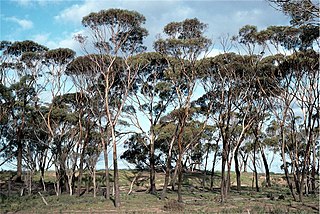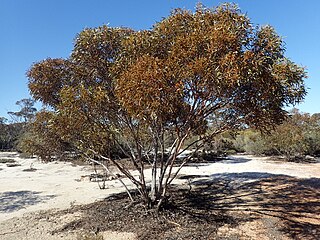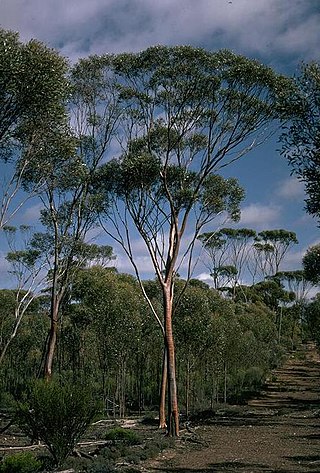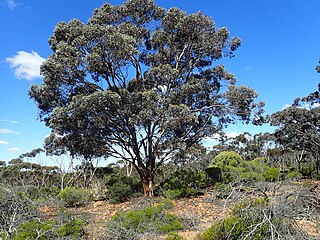
Eucalyptus fraseri, commonly known as Balladonia gum, is a species of tree or mallet that is endemic to Western Australia. It has smooth white to greyish bark, lance-shaped or curved adult leaves, flower buds in groups of seven or nine, white flowers and cup-shaped, conical or hemispherical fruit.

Eucalyptus falcata, commonly known as silver mallet or toolyumuck, is a species of mallee or marlock that is endemic to Western Australia. It has smooth bark, lance-shaped to curved adult leaves, flower buds in groups of eleven or thirteen, creamy white or yellowish green flowers and flattened spherical fruit.

Eucalyptus kondininensis, commonly known as Kondinin blackbutt, is a species of tree that is endemic to Western Australia. It has rough, black bark on the trunk, smooth grey to white bark on the branches, lance-shaped adult leaves, flower buds in groups of seven, white flowers and cup-shaped to conical fruit.

Eucalyptus latens, commonly known as narrow-leaved red mallee, is a species of mallee that is endemic to the south-west of Western Australia. It has smooth grey and coppery bark, linear to narrow lance-shaped adult leaves, flower buds in groups of seven to eleven or more, creamy white flowers and small barrel-shaped to shortened spherical fruit.

Eucalyptus pileata, commonly known as the capped mallee, is a species of mallee that is native to South Australia and Western Australia. It has smooth greyish bark, narrow lance-shaped adult leaves, flower buds in groups of seven, white flowers and cup-shaped, conical or barrel-shaped fruit.
Eucalyptus polita, also known as Parker Range mallet, is a species of mallet or small tree that is endemic to the southwest of Western Australia. It has smooth, greyish bark, narrow lance-shaped adult leaves, flower buds in groups of between seven and eleven, white flowers and cup-shaped fruit.
Eucalyptus praetermissa is a species of mallet that is endemic to a small area on the south coast of Western Australia. It has smooth bark, lance-shaped adult leaves, flower buds in groups of up to fifteen, creamy white to pale yellow flowers and cylindrical to barrel-shaped fruit.
Eucalyptus prolixa, commonly known as the square-fruited mallet, is a species of mallet that is endemic to the southwest of Western Australia. It has smooth bark, glossy green, lance-shaped adult leaves, flower buds in groups of seven, creamy white flowers and urn-shaped fruit that is square in cross-section.

Eucalyptus sargentii, commonly known as Salt River gum, is a species of mallet, mallee or small tree that is endemic to Western Australia. It has rough bark on part or all of the trunk, smooth bark above, linear to narrow lance-shaped leaves, flower buds in groups of seven, whitish to creamy yellow flowers and conical fruit.

Eucalyptus steedmanii, commonly known as Steedman's gum or Steedman's mallet, is a species of mallet that is endemic to a small region of Western Australia. It has smooth, satiny bark, narrow elliptical leaves, flower buds in groups of three, white flowers and conical, four-winged fruit.
Eucalyptus subangusta is a species of tree, mallee or mallet that is endemic to the southwest of Western Australia. It has smooth bark, narrow lance-shaped leaves, flower buds in groups of up to nineteen, white flowers and cup-shaped to barrel-shaped fruit.
Eucalyptus tenuis is a species of slender mallet that is endemic to the southwest of Western Australia. It has smooth bark, lance-shaped adult leaves, flower buds in groups of three, creamy white flowers and conical, cup-shaped or bell-shaped fruit.
Eucalyptus thamnoides, also known as brown mallee, is a species of mallee that is endemic to south western Western Australia. It has smooth bark, lance-shaped adult leaves, flower buds in groups of seven, cream-coloured to pale yellow flowers and cup-shaped, conical or bell-shaped fruit.

Eucalyptus clivicola, commonly known as green mallet, is a species of eucalypt that is endemic to Western Australia. It has smooth bark, linear to lance-shaped adult leaves, flower buds in groups of between nine and thirteen, pale yellow flowers and barrel-shaped, conical or cylindrical fruit.

Eucalyptus densa is a species of mallee or mallet that is endemic to Western Australia. It has smooth greyish bark that is shed in curly strips, linear to narrow lance-shaped adult leaves, long, spindle-shaped flower buds in groups of seven or nine, pale yellow or lemon-coloured flowers and conical, cylindrical or barrel-shaped fruit.
Eucalyptus rhomboidea, commonly known as the diamond gum, is a species of mallet or tree that is endemic to the southwest of Western Australia. It has smooth bark, lance-shaped adult leaves, flower buds in groups of seven, pale yellow flowers and cup-shaped to funnel-shaped fruit that is glaucous at first.
Eucalyptus alipes, also known as Hyden mallet, is a mallet that is endemic to the south-west of Western Australia. It has smooth grey to light brown or bronze bark, linear to narrow elliptic leaves, oval to spindle-shaped buds with a long, narrow operculum and conical fruits.
Eucalyptus distuberosa is a species of mallet that is endemic to the south-west of Western Australia. It has smooth dark grey to tan-coloured or creamy white bark, glossy dark green, lance-shaped adult leaves, flower buds in groups of seven, white flowers and cup-shaped to conical fruit.
Eucalyptus purpurata, commonly known as the Bandalup silver mallet, is a species of mallet that is endemic to a small area in the southwest of Western Australia. It has smooth, silvery bark, glossy dark green, lance-shaped adult leaves, flower buds in groups of between seven and eleven, creamy white flowers and shortened spherical fruit.
Eucalyptus rugulata is a species of mallet or tree that is endemic to a restricted area of Western Australia. It has smooth bark, lance-shaped adult leaves, ribbed flower buds in groups of seven, creamy white flowers and shortened spherical fruit.










